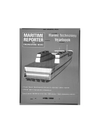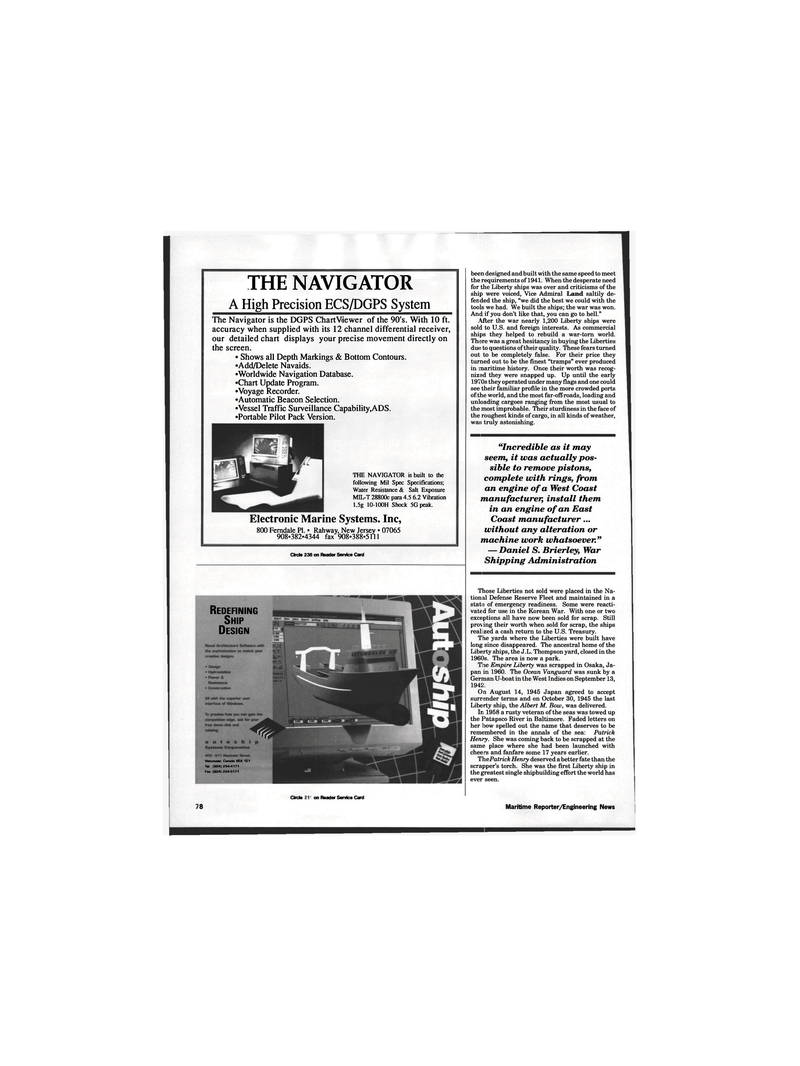
Page 66: of Maritime Reporter Magazine (April 1995)
Read this page in Pdf, Flash or Html5 edition of April 1995 Maritime Reporter Magazine
THE NAVIGATOR
A High Precision ECS/DGPS System
The Navigator is the DGPS Chart Viewer of the 90's. With 10 ft. accuracy when supplied with its 12 channel differential receiver, our detailed chart displays your precise movement directly on the screen. • Shows all Depth Markings & Bottom Contours. •Add/Delete Navaids. •Worldwide Navigation Database. •Chart Update Program. •Voyage Recorder. •Automatic Beacon Selection. •Vessel Traffic Surveillance Capability,ADS. •Portable Pilot Pack Version.
THE NAVIGATOR is built to the following Mil Spec Specifications;
Water Resistance & Salt Exposure
MIL-T 28800c para 4.5 6.2 Vibration 1.5g 10-100H Shock 5G peak.
Electronic Marine Systems. Inc, 800 Ferndale PI. • Rahway, New Jersey • 07065 908*382.4344 fax 908'388*5111
Circle 238 on Reader Service Card been designed and built with the same speed to meet the requirements of 1941. When the desperate need for the Liberty ships was over and criticisms of the ship were voiced, Vice Admiral Land saltily de- fended the ship, "we did the best we could with the tools we had. We built the ships; the war was won.
And if you don't like that, you can go to hell." i\fter the war nearly 1,200 Liberty ships were sold to U.S. and foreign interests. As commercial ships they helped to rebuild a war-torn world.
There was a great hesitancy in buying the Liberties due to questions of their quality. These fears turned out to be completely false. For their price they tinned out to be the finest "tramps" ever produced in maritime history. Once their worth was recog- nized they were snapped up. Up until the early 1970s they operated under many flags and one could see their familiar profile in the more crowded ports of the world, and the most far-off roads, loading and unloading cargoes ranging from the most usual to the most improbable. Their sturdiness in the face of the roughest kinds of cargo, in all kinds of weather, was truly astonishing. "Incredible as it may seem, it was actually pos- sible to remove pistons, complete with rings, from an engine of a West Coast manufacturer, install them in an engine of an East
Coast manufacturer... without any alteration or machine work whatsoever." — Daniel S. Brierley, War
Shipping Administration
Those Liberties not sold were placed in the Na- tional Defense Reserve Fleet and maintained in a state of emergency readiness. Some were reacti- vated for use in the Korean War. With one or two exceptions all have now been sold for scrap. Still proving their worth when sold for scrap, the ships real ized a cash return to the U.S. Treasury.
The yards where the Liberties were built have long since disappeared. The ancestral home of the
Liberty ships, the J.L. Thompson yard, closed in the 1960s. The area is now a park.
The Empire Liberty was scrapped in Osaka, Ja- pan in 1960. The Ocean Vanguard was sunk by a
German U-boat in the West Indies on September 13, 1942.
On August 14, 1945 Japan agreed to accept surrender terms and on October 30, 1945 the last
Liberty ship, the Albert M. Bow, was delivered.
In 1958 a rusty veteran of the seas was towed up the Patapsco River in Baltimore. Faded letters on her bow spelled out the name that deserves to be remembered in the annals of the sea: Patrick
Henry. She was coming back to be scrapped at the same place where she had been launched with cheers and fanfare some 17 years earlier.
ThePatrick Henry deserved a better fate than the scrapper's torch. She was the first Liberty ship in the greatest single shipbuilding effort the world has ever seen.
Circle 333 on Reader Service Card
REDEFINING
SHIP
DESIGN
Vancouver, Canada VGA 1E1
Tel: [604] 254-4171
Fax: (604J 254-5171 82 Maritime Reporter/Engineering News

 65
65

 67
67
